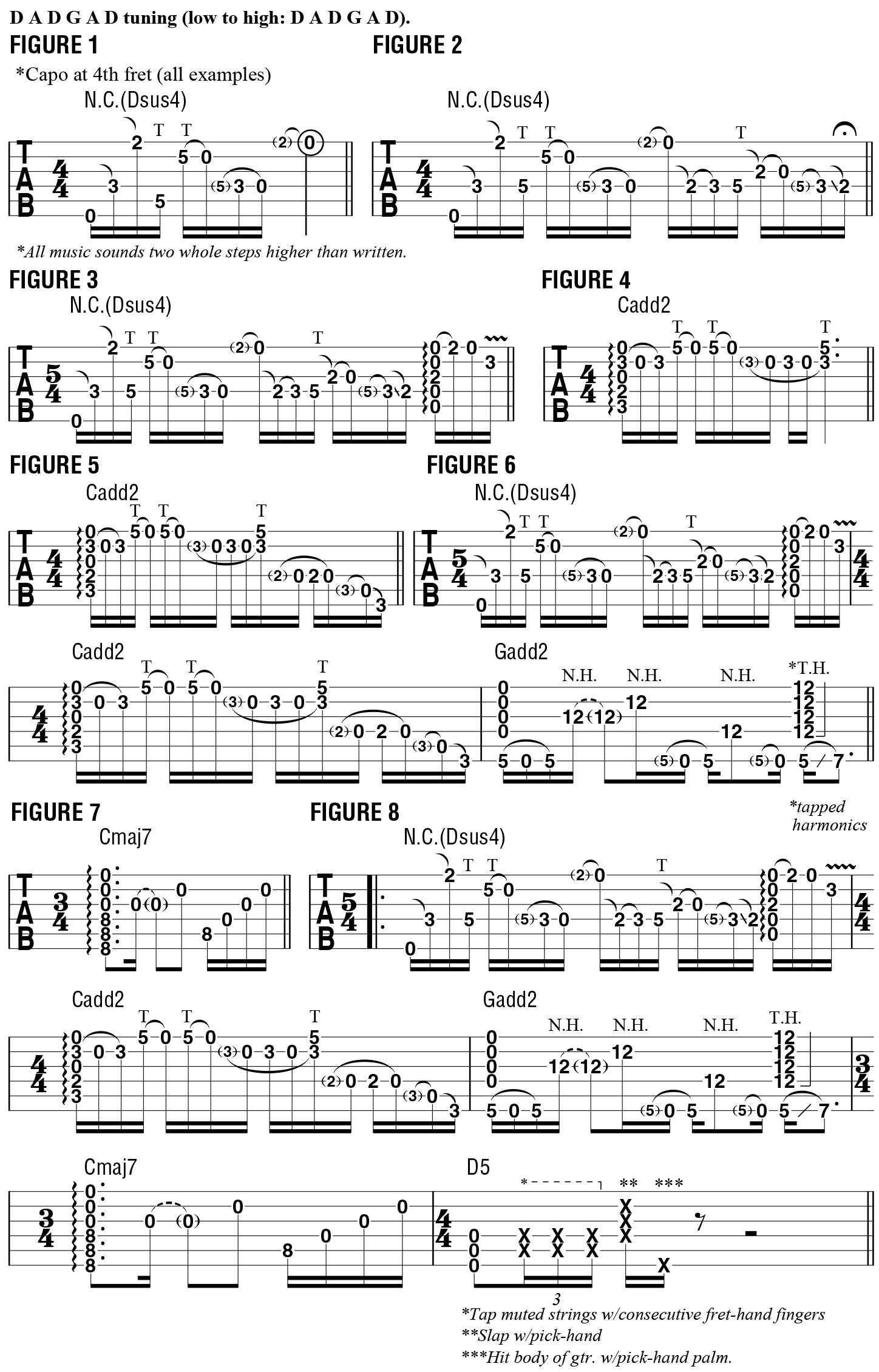Intertwining Hammer-Ons and Pull-Offs with Both Hands
Hello everyone, and welcome to my new series of Guitar World columns.
I’d like to begin this new round with a look at the two-hand tapping techniques I use on a track called “Melancholia” (check it out below), which I recorded as a guest spot with the band John Brown’s Flux Conduct for their 2016 album, Yetzer Hara: The Second Concept Album. Many of you may know John from his work with the U.K. tech-metal band Monuments.
To me, fretboard tapping on an acoustic guitar is very different from tapping on an electric because when tapping on an acoustic I often think vertically—moving across the strings within a fixed group of frets—rather than horizontally, moving up and down the length of the fretboard.
For this song, my guitar is in DADGAD tuning (low to high, D A D G A D) with a capo at the fourth fret. One of the nice advantages this tuning offers you is the ability to easily sound octaves, fifths and desirable combinations of harmonics by fretting different strings at the same fret, such as with a barre fingering. Regarding my use of the capo here, I refer to all notes and chords as if the capo were the nut, or zero fret. So, for example, I’ll refer to the open sixth string as “D,” although it actually sounds a concert-pitch Fs due to the capo transposition.
An essential aspect of two-hand tapping is for the volume and attack of the notes to remain even and consistent between the two hands. In the actual musical piece, this first bar is in 5/4, but I would like to walk you through each beat before addressing the entire 5/4 bar.

FIGURE 1 illustrates the initial tapped pattern, which is initiated with a slap on the open sixth string, followed by fret-hand taps on the fourth string’s third fret and the first string’s second fret, consecutively. I then bring my pick hand into play, tapping my index and middle fingers onto the fifth fret of the fourth and second strings, consecutively, followed by a double pull-off to the open fourth string, as well as a pull-off to the open first string. Play this sequence repeatedly until it feels and sounds smooth, even and in time.
In FIGURE 2, the phrase is extended through beats three and four, via more fret-hand taps, hammer-ons, pull-offs and finger slides, along with another single pick-hand tap.
FIGURE 3 brings a raked Dsus4 chord into the mix, on beat five. FIGURE 4 illustrates the subsequent Cadd2 chord, also raked from low to high, and the pattern played across the next four beats. FIGURE 5 shows the full bar of 5/4, as I performed it on the recording. Now that we have the first two bars down, let’s play them along with new material in bar 3, shown in FIGURE 6, wherein natural harmonics (N.H.) are added while sustaining a Gadd2 chord.
Finally, FIGURE 7 brings in the closing chord and melodic pattern. All elements have been combined in the complete excerpt presented in FIGURE 8. Be sure to work through each bar slowly and carefully as you navigate through this challenging example.
Mike Dawes is a British guitarist and touring musician, hailed as one of the world's most creative fingerstyle performers. His new album, Era, is available now. For more information, visit mikedawes.co.uk.
Get The Pick Newsletter
All the latest guitar news, interviews, lessons, reviews, deals and more, direct to your inbox!
“There are so many sounds to be discovered when you get away from using a pick”: Jared James Nichols shows you how to add “snap, crackle and pop” to your playing with banjo rolls and string snaps
Don't let chord inversions bamboozle you. It's simply the case of shuffling the notes around







![Joe Bonamassa [left] wears a deep blue suit and polka-dotted shirt and plays his green refin Strat; the late Irish blues legend Rory Gallagher [right] screams and inflicts some punishment on his heavily worn number one Stratocaster.](https://cdn.mos.cms.futurecdn.net/cw28h7UBcTVfTLs7p7eiLe.jpg)


